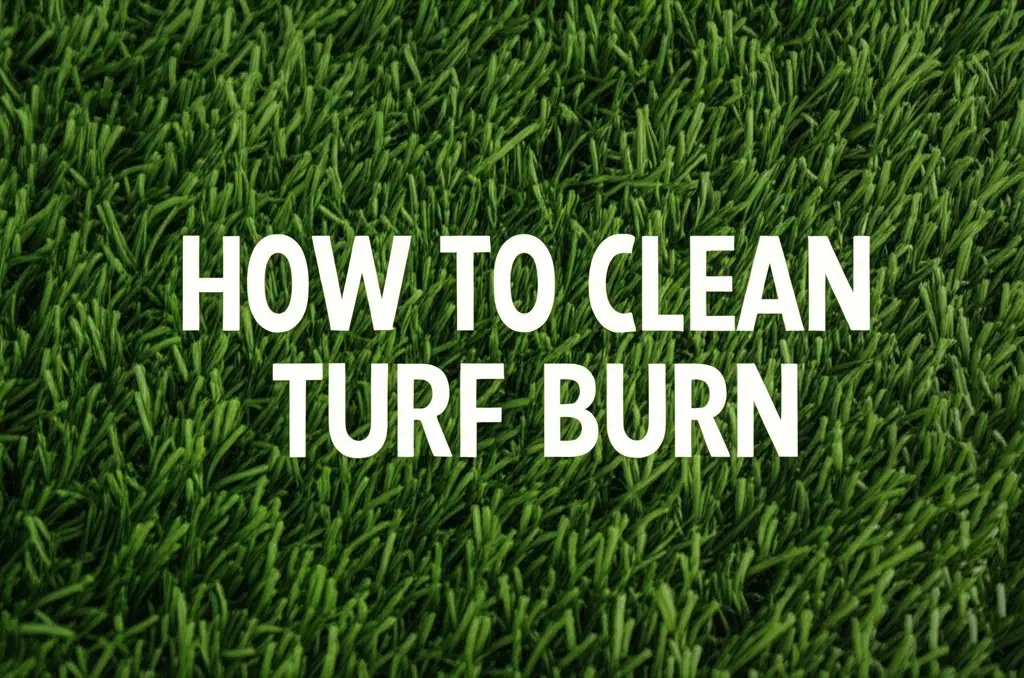· Health & Safety · 13 min read
How To Clean Turf Burn

How To Clean Turf Burn: Essential First Aid Steps
Getting a turf burn can really put a damper on your game or activity. This common injury happens on artificial playing fields. It causes painful scrapes and redness on your skin. You might wonder how to properly care for it. Knowing how to clean turf burn correctly is crucial. It helps prevent infection and promotes faster healing. This guide will walk you through every step. We cover immediate first aid to long-term care and prevention.
Takeaway
- Clean Immediately: Rinse turf burns with cool water and mild soap right away.
- Remove Debris: Carefully pick out any dirt or turf particles to prevent infection.
- Dress Wounds: Apply an antiseptic and cover the area with a sterile, non-stick bandage.
- Monitor for Infection: Watch for signs like increased pain, redness, swelling, or pus.
- Prevent Future Burns: Wear appropriate protective gear during activities on artificial turf.
Cleaning a turf burn involves immediate rinsing with cool water and mild soap to remove debris and dirt. Then, you should gently blot the wound dry. Apply an antiseptic solution or ointment. Finally, cover the area with a sterile, non-stick dressing to protect it and encourage healing.
Understanding Turf Burn: What It Is and Why It Happens
Turf burn is a type of skin abrasion. It occurs when your skin slides across artificial turf surfaces. The friction causes the outer layers of your skin to scrape away. This can happen during sports like soccer or football. Any activity on turf without proper protection can lead to it.
The rough texture of artificial turf is the main culprit. It creates more friction than natural grass. When you fall or slide, your skin rubs hard against the surface. This friction generates heat and scrapes off skin cells. It leaves behind an open wound. The injury often includes small pieces of turf or dirt embedded in the skin. This makes proper cleaning even more important. A turf burn looks like a red, raw, or scraped area. It can range from mild to severe, depending on the depth of the scrape. Sometimes, small blisters might form around the wound.
I have seen many athletes deal with turf burns. They often underestimate the pain. They also overlook the risk of infection. The plastic fibers and rubber pellets in artificial turf can carry bacteria. These materials can also get stuck in the wound. This makes it a perfect breeding ground for germs. It is important to treat these wounds seriously. Quick action helps prevent complications. Knowing the cause helps you avoid future injuries. You can also take better care of your skin right after an incident. This early understanding sets the stage for effective care.
Immediate First Aid for Turf Burn: The Crucial First Steps
When you get a turf burn, acting fast is very important. The first moments after the injury dictate how well the wound heals. Your goal is to clean the wound. This stops bacteria from causing infection. You also want to relieve immediate pain. I always tell people to stay calm first. A clear head helps you perform the right steps.
First, stop the activity immediately. This prevents further injury. Assess the wound’s severity. If the burn is deep or very large, seek medical help right away. For most turf burns, you can start home treatment. Your first step is to clean your hands. Use soap and water or a hand sanitizer. This prevents transferring germs to the open wound. Germs can easily enter a scraped area. Clean hands protect you from infection.
Next, rinse the turf burn with cool, clean water. Do this gently but thoroughly. Let the water run over the wound for several minutes. This washes away loose dirt and debris. You can use a mild, non-perfumed soap around the edges of the wound. Do not rub soap directly into the raw skin. Soap can irritate an open wound. The goal is to flush out any particles. Think of it like rinsing a dirty dish. You want to remove all visible dirt. This initial rinse is critical for effective wound care and healing. It prepares the wound for deeper cleaning and dressing.
Thorough Cleaning Techniques for Turf Burn Wounds
After the initial rinse, a more detailed cleaning is necessary. Turf burns often have embedded particles. These small pieces of turf, dirt, or rubber pellets must come out. Leaving them in increases the risk of infection. It also slows down healing. Start by gathering your supplies. You will need clean tweezers, antiseptic solution, cotton swabs, and clean gauze.
Gently blot the wound dry with a clean cloth or sterile gauze. Do not rub the area. Then, look closely at the wound. Use the clean tweezers to carefully pick out any visible debris. Be very gentle to avoid further skin damage. If particles are deeply embedded, or if removal causes extreme pain or bleeding, do not force them out. This indicates a need for medical attention. A doctor can remove deeply embedded items safely. For surface particles, take your time. Ensure you remove as much as possible.
Once you remove loose debris, apply an antiseptic. Options include povidone-iodine, chlorhexidine, or hydrogen peroxide. Dilute hydrogen peroxide as directed on the label. Apply it to a clean cotton swab. Gently dab it over the entire turf burn. This helps kill any remaining bacteria on the skin surface. Some people prefer saline solution for cleaning. It is less irritating than antiseptics. Saline effectively washes away germs without stinging. Either way, the goal is to fully sanitize the wound. Proper cleaning makes sure no harmful bacteria remain. This step is vital in preventing serious infections. Remember, a clean wound heals best.
Protecting and Dressing Your Turf Burn Wound
Once the turf burn is thoroughly cleaned, protecting it is the next step. An open wound needs a barrier. This barrier keeps out bacteria and dirt. It also maintains a moist environment. A moist environment is best for skin healing. I always make sure to have proper dressing materials on hand. These include non-stick pads and medical tape.
First, apply a thin layer of antibiotic ointment to the wound. Products like Neosporin or Bacitracin work well. These ointments provide moisture. They also add a layer of defense against bacteria. The ointment helps prevent the bandage from sticking to the raw skin. This makes bandage changes less painful later. It is a small step that makes a big difference. Be sure to cover the entire raw area.
Next, choose the right bandage. A non-stick pad or sterile gauze pad is ideal. Cut the pad to a size that covers the wound completely. It should extend slightly beyond the edges. Secure the pad with medical tape. Make sure the tape holds the dressing firmly in place. However, do not wrap it too tightly. Overly tight bandages can cut off circulation. They can also cause discomfort. You want the bandage to protect the wound without causing pressure. Change the dressing at least once a day. If it gets wet or dirty, change it sooner. Each time you change the dressing, gently clean the wound again. This keeps the wound fresh and promotes healing. Proper dressing protects your skin.
Types of Dressings for Turf Burn
- Non-Stick Pads: These are soft, absorbent pads. They have a special coating. This coating prevents them from sticking to the wound. This is important for painful abrasions like turf burn.
- Hydrogel Dressings: These gel-based pads provide a moist environment. They help the skin heal faster. They also feel cool on the burn.
- Hydrocolloid Dressings: These dressings are self-adhesive. They form a gel over the wound. This gel absorbs fluid and creates a protective barrier. They can stay on for several days.
- Gauze Pads: Standard gauze is absorbent. Use it with a non-stick layer underneath. This prevents it from sticking directly to the wound.
Managing Pain and Preventing Infection After Turf Burn
After you clean and dress your turf burn, managing pain and preventing infection become top priorities. Turf burns can be quite painful. They leave nerve endings exposed. Infection is also a real threat. Bacteria can easily enter the open skin. Taking these steps seriously ensures a smoother recovery.
For pain relief, over-the-counter pain medications help. Ibuprofen or acetaminophen can reduce discomfort. Follow the dosage instructions on the label. Applying a cool compress to the area can also soothe the pain. Just be sure the compress is clean. Do not apply ice directly to the raw skin. Wrap ice in a clean cloth. Elevating the injured area can also reduce swelling and throbbing pain. This is especially helpful if the burn is on a limb.
Preventing infection is crucial. Watch for signs of infection carefully. These include increasing pain, redness, or swelling around the wound. Pus or foul-smelling discharge are clear infection indicators. Fever or red streaks spreading from the wound also signal infection. If you see any of these signs, seek medical attention. A doctor may prescribe antibiotics. This prevents the infection from spreading. Continue to clean the wound daily. Change the dressing as instructed. Maintaining a clean environment around your injury is very important for healing. Regularly check the wound’s progress. A healthy wound will gradually look less red and begin to form new skin.
When to Seek Medical Attention for Turf Burn
While many turf burns can be treated at home, some situations require professional medical care. Knowing when to see a doctor is very important. It can prevent complications. Ignoring severe symptoms can lead to serious health issues. Always prioritize your health and well-being.
You should seek medical attention if:
- The burn is very deep or large: If the scrape goes beyond the top layers of skin. Or if it covers a significant area of your body.
- The wound shows signs of infection: This includes increasing pain, redness, swelling, or warmth around the wound. Also look for pus, fever, or red streaks spreading from the injury.
- Debris is deeply embedded: If you cannot remove dirt or turf particles safely at home. A doctor can remove them without causing further damage.
- Bleeding does not stop: If applying pressure does not stop the bleeding within a few minutes.
- The burn is on a joint or sensitive area: Wounds over joints, or on the face, hands, or feet, need careful assessment. They may require specialized treatment.
- You have underlying health conditions: People with diabetes or weakened immune systems need quicker medical review. Even minor wounds can become serious for them.
- Pain is severe or worsens: If the pain is unbearable or increases despite home care.
- No improvement after a few days: If the wound shows no signs of healing, or looks worse, after 3-5 days.
A doctor can properly assess the wound. They can also clean it professionally. They might prescribe stronger antibiotics if needed. Timely medical intervention ensures proper healing. It also minimizes scarring. Do not hesitate to get help if you are unsure. It is always better to be safe.
Preventing Future Turf Burn Incidents
Preventing turf burn is better than treating it. Taking a few proactive steps can significantly reduce your risk. This is especially true if you frequently play or exercise on artificial turf. Protection is key. I have learned from experience that proper gear makes a huge difference.
First, wear appropriate protective clothing. Long sleeves and pants are your best defense. Choose clothing made from synthetic materials that can withstand friction. These materials often have a smooth outer surface. They allow you to slide without direct skin contact. Padded compression shorts or sleeves can also offer extra protection. These items provide cushioning. They also create a barrier between your skin and the turf. Make sure your clothing fits well. Loose clothing can bunch up and expose skin.
Next, consider using protective gear. Sliding pads designed for specific sports are excellent. These pads cover common areas for turf burns like hips, knees, and elbows. Some athletes use athletic tape or pre-wrap on exposed skin. This adds another layer of defense. Maintaining the playing surface also helps. Report any tears or uneven spots on the turf. A well-maintained surface reduces hazards. Regularly cleaning turf from dog pee or other debris contributes to overall safety. This broad commitment to hygiene helps prevent problems. Lastly, practice proper sliding techniques if you play sports. Learn to slide safely. This minimizes skin contact with the ground. By combining protective gear with smart practices, you can enjoy turf sports with fewer worries about painful burns.
FAQ Section
Q1: How long does turf burn take to heal?
Most minor turf burns heal within 1 to 2 weeks. Deeper abrasions may take longer, sometimes 3 to 4 weeks. Proper cleaning and dressing can speed up the process. Factors like your general health and how well you care for the wound also affect healing time. Consistent daily care is essential for faster recovery.
Q2: Can I get an infection from turf burn?
Yes, turf burn carries a high risk of infection. Artificial turf often contains bacteria, dirt, and rubber particles. These can enter the open wound. Signs of infection include increasing pain, redness, swelling, pus, or fever. Prompt cleaning and proper wound care are crucial to prevent infection.
Q3: Should I cover turf burn or let it air out?
You should always cover a turf burn. Keeping the wound covered with a sterile, non-stick dressing protects it from bacteria and debris. A moist environment under the bandage also promotes faster and better healing. Letting it air out can dry the wound, which slows healing and increases infection risk.
Q4: What cleaning solutions should I avoid on turf burn?
Avoid harsh antiseptic solutions like undiluted rubbing alcohol or iodine directly on the open wound. These can damage healthy skin cells. This slows down healing. Do not use strong household cleaners. For instance, while you might use vinegar to clean a shower, it is not for open wounds. Stick to mild soap and water, saline solution, or diluted antiseptic specifically for wounds.
Q5: Can I play sports with a turf burn?
It is generally not recommended to play sports with an open turf burn. Further activity can irritate the wound. It can also introduce more bacteria. This increases the risk of infection. Give your wound time to heal. Ensure it is fully covered and protected if you must return to activity. Consult a doctor or coach for specific guidance.
Conclusion
Understanding how to clean turf burn properly is vital. It means the difference between a quick recovery and potential complications. You have learned the importance of immediate action. You also know about thorough cleaning, effective wound dressing, and vigilant monitoring for infection. Remember, preventing turf burn is your best defense. Wear protective gear. Pay attention to how you move on the turf.
Always keep a basic first aid kit handy. It should contain supplies for wound care. By following these steps, you can confidently manage turf burn. You can also minimize its impact on your active lifestyle. Your skin will thank you. Take care of your body. It allows you to continue enjoying your favorite activities safely.
- turf burn treatment
- wound care
- first aid
- skin abrasions
- sports injuries




